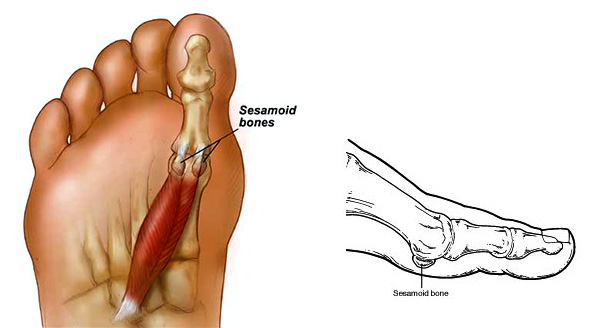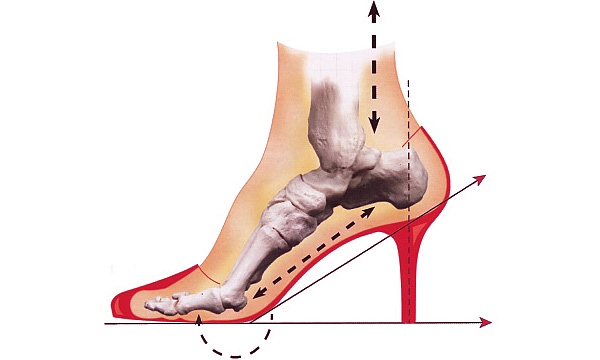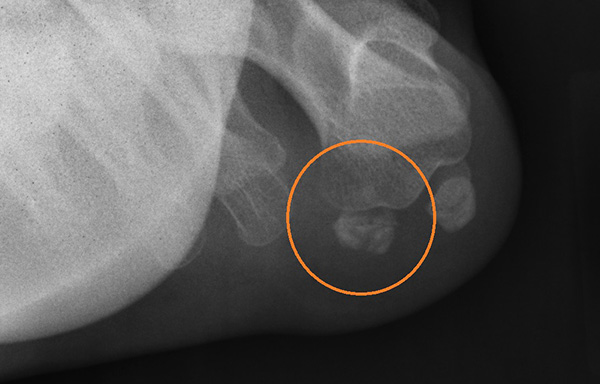Sesamoid bones are pea-shaped bones located in the ball of the foot, beneath the big toe joint. It is embedded in a tendon that stabilizes the big toe joint. Acting as pulley for tendons, the sesamoids help the big toe move normally and provide leverage when the big toe “pushes off” during walking and running. The sesamoids also serve as a weight-bearing surface for the first metatarsal bone (the long bone connected to the big toe), absorbing the weight placed on the ball of the foot when walking, running, and jumping.

Sesamoids are two small bones under the big toe joint.
Sesamoid injuries can involve the bones, tendons, and/or surrounding tissue in the joint. They are often associated with activities requiring increased pressure on the ball of the foot, such as running, basketball, football, golf, tennis, and ballet. In addition, people with high arches are at risk for developing sesamoid problems. Frequent wearing of high-heeled shoes can also be a contributing factor.
Common Sesamoid Injuries
Sesamoiditis
This is an overuse injury involving acute or chronic inflammation of the sesamoid bones and the tenons involved with those bones. Sesamoiditis is caused by increased pressure to the sesamoids. Often, sesamoidititis is associated with a dull, longstanding pain beneath the big toe joint. The pain comes and goes, usually worse with increased activity and flexible or high heeled shoes.

High heels or shoes that are too flexible can lead to injuries of the sesamoid due to increase pressure in this area.
Fracture
An acute fracture is caused by trauma – a direct blow or impact to the bone. An acute sesamoid fracture produces immediate pain and swelling at the site of the break, but usually does not affect the entire big toe joint. A chronic fracture is a stress fracture (a hairline break usually caused by repetitive stress or overuse). A chronic sesamoid fracture produces longstanding pain in the ball of the foot beneath the big toe joint. The pain, which tends to come and go, generally is aggravated with activity and relieved with rest.

Sesamoid fracture.
Turf Toe
This is an injury of the soft tissue surrounding the big toe joint. It usually occurs when the big toe joint is extended beyond its normal range. Turf toe causes immediate, sharp pain and swelling. It usually affects the entire big toe joint and limits the motion of the toe. Turf toe may result in an injury to the soft tissue attached to the sesamoid or a fracture of the sesamoid. Sometimes a “pop” is felt at the moment of injury.
Diagnosis
In diagnosing a sesamoid injury, the foot specialist will examine the foot, focusing on the big toe joint. The doctor will press on the big toe, move it up and down, and may assess the patient’s walking and evaluate the wear pattern on the patient’s shoes. Xrays can be ordered to rule out fracture, and in some cases, advanced imaging studies such as bone scan or CT scan may be ordered.
Treatment
Based on the exam, conservative treatment may consist of padding, taping, or immobilizing the foot for immediate relief. The doctor may also recommend oral medications or physiotherapy. Often, custom orthotics can be very helpful in minimizing pressure over sesamoids and correct any malalignment. In some cases when more aggressive treatment is needed to improve pain, a steroid injection can be administered into the joint. Lastly, if conservative treatment fail, surgery may be required.
If you believe you have obtained a sesamoid injury, don’t wait for it to get worse. A foot specialist can help you get back on your feet. Contact us for a consultation with Dr. Wang today!

